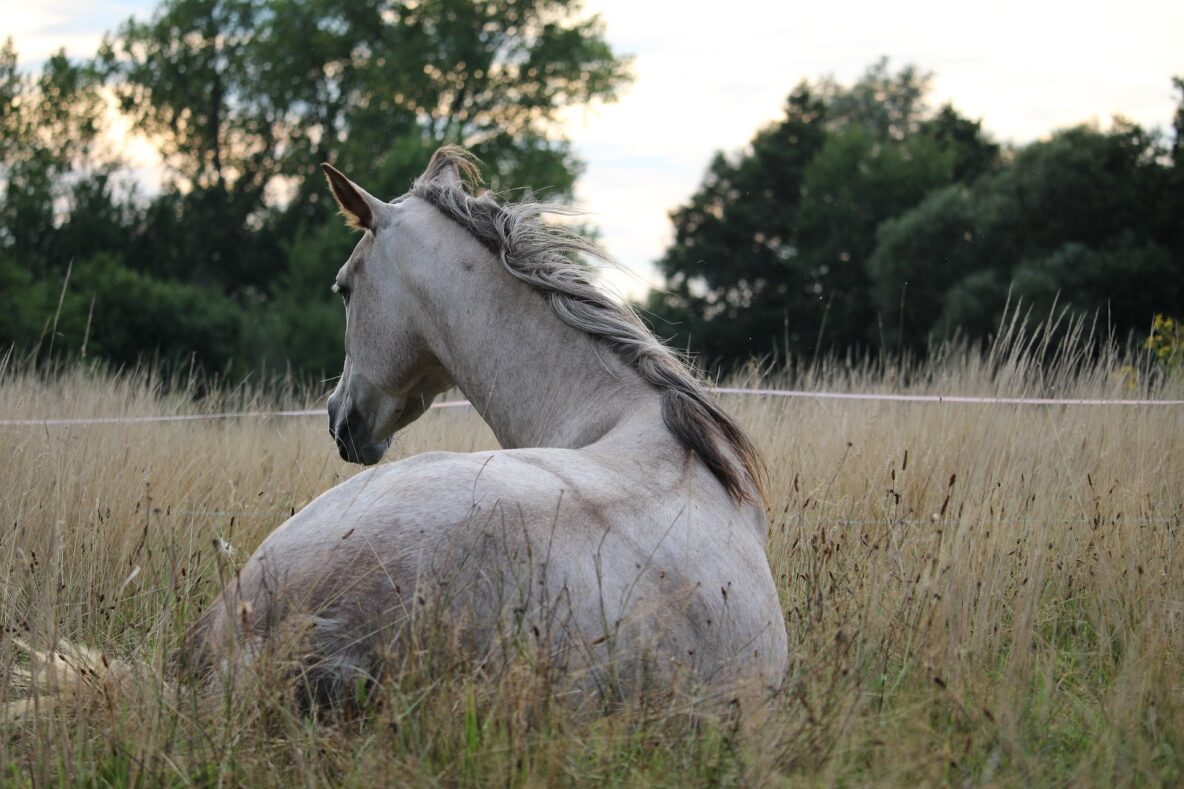Pregnant Mare Care
During the first 30 days, there is a 10 to 15 percent chance that the embryo will be resorbed. Stress, illness, uterine infection, hormonal abnormalities, the presence of twins and other factors have been implicated in early embryonic loss. Often, the cause remains undetermined.
When the mare conceives, the fertilized egg (zygote) travels down the fallopian tubes and enters the uterus around day six to seven. It migrates throughout the uterus until about day 16 and typically “sticks” onto the uterine wall at 16 to 17 days. By day 12 to 13, the embryonic vesicle is usually large enough to be detected by ultrasonic examinations. Studs may tease the mare 14 to 20 days after her last breeding date to see if she comes back into oestrus. If she does not, the pregnancy and its heartbeat may then be detected by ultrasound. Trans-rectal palpation, at approximately 30 to 35 days post-breeding, can usually confirm pregnancy. Ultrasound examination at 14 to 16 days post-ovulation can confirm pregnancy and detect the presence of multiple embryos (twins).
Teasing, palpation or ultrasound has not been shown to harm the developing embryo or endanger the pregnancy. However, because of the embryo’s uncertain beginning, it may be wise to have the pregnancy reconfirmed between 45 to 90 days post-ovulation since this is the time period when resorption is most likely. A mare confirmed in foal by ultrasonography at 14 days and/or 30 days will not necessarily still have a foetus 10 months later. The ability of your mare to maintain a pregnancy through the first 90 days needs to be confirmed by a vet.
TWINS
An ultrasound exam at 14 to 16 days post-ovulation to detect twins. Early detection of twins provides an opportunity to eliminate one embryo, thus allowing the other to develop normally. This is commonly done because twins pose a number of risks:
- In 95 percent of mares with twin embryos, one or both embryos are resorbed or aborted during the first 60 days. However, waiting to see if this occurs naturally could delay or interfere with a subsequent successful pregnancy.
- Of the small percentage of twins that survive in utero past 50 days, it is highly unlikely that two healthy foals will be born. If either survives, it may be small and weak.
- Most twins surviving past 50 days will spontaneously abort at 6 to 8 months.
- Mares carrying twins are more likely to give birth prematurely (before 300-320 days). Premature foals may have serious medical problems and are less likely to survive.
CARE OF THE BROOD MARE
Good broodmare management is the best aid for helping the mare make it through the critical first 30 to 60 days of pregnancy.
The mare should go into the breeding season fit and perhaps gaining weight. Severely underweight mares will have more trouble conceiving than will mares of appropriate weight.
Avoid stressing the mare as much as possible. Stress can cause a drop in progesterone, a hormone which helps maintain pregnancy. Illness and/or fever can cause the mare’s system to secrete prostaglandins, which may cause abortion.
BEST JUDGMENT
- Transport your mare only if necessary.
- Use caution when exposing your mare to other horses. You should avoid any undue risk of injury or disease transmission by isolating broodmares from transient horse populations.
- Provide nutritious forage, but don’t overfeed. Supplementing with vitamins and minerals is unnecessary in mares being fed a balanced diet.
- Make sure the mare is current on vaccines and deworming. Consult your vet for recommendations regarding specific vaccinations and deworming interval during pregnancy.
- Do not administer hormones or other drugs unless specifically prescribed by your vet.
- Carefully evaluate the mare before deciding whether to breed on foal heat. Take advise from your vet.
MIDDLE PREGNANCY
Unless there are special circumstances, during the first 7 months of pregnancy, treat your mare as you would a non-pregnant one. She will benefit from moderate riding or exercise. There is no reason to increase your mare’s caloric intake until the last three to four months of pregnancy. Constantly evaluating her body condition is a better way of altering her diet rather than feeding her more because you “think she needs it.”
The ration should be composed primarily of high-quality forage in approximately the same as pre-pregnancy amounts. Extremes in weather can alter her nutritional requirements and should be taken into account when formulating the ration. She should always have plenty of clean, fresh water. The mare will also benefit from routine hoof and dental care, standard vaccinations and regular deworming.
VACCINATION
Vaccinations should be current, since infectious diseases can trigger abortions. The mare should be vaccinated for Eastern and Western encephalomyelitis, West Nile virus, influenza, and tetanus at the beginning of pregnancy. A booster should be given one month prior to foaling to increase the antibody level in the mare’s colostrum (first milk) and help protect the new born foal from disease. Also, the mare should be vaccinated against equine rhinopneumonitis (commonly called virus abortion or rhino) at five, seven and nine months’ gestation. Consult with your local veterinarian regarding other vaccines that may be advisable in your area, such as rabies, rotavirus and botulism.
DEWORMING
Most deworming agents available today are relatively safe for pregnant mares. Consult your vetto establish an effective and safe deworming schedule for your mare.
It is especially important to deworm the mare within several weeks of foaling, because the mare will be the primary source for infecting her foal with parasites. Of course, manure should always be properly disposed of.
CHANGING NEEDS
During the last four months of pregnancy, the foal will grow rapidly. To accommodate this growth, the mare’s energy needs will increase. Even so, special nutritional supplements are probably unnecessary. Good-quality hay and forage should remain the bulk of the expectant mare’s diet. Concentrated feeds, such as grains, may be added to the ration to bolster energy intake without adding excess bulk.
Use the mare’s body condition as your guide to how she’s faring. Adjust the ration accordingly. The mare should not become obese. Your vet can advise you regarding a proper nutritional program for your mare.
Exercise during the last four months of the mare’s pregnancy should be light to moderate. In fact, a pastured mare will get as much exercise as she needs just grazing. Vigorous exercise is not recommended.
HOME STRETCH
The average length of pregnancy in the mare is 338 to 343 days. However, normal gestation can range from 320 to 380 days. You needn’t become overly concerned if your mare is past due. Prolonged gestation is not generally associated with problems or extra large foals unless the mare is grazing endophyte-infected fescue grass. If your mare’s pregnancy extends much past 340 days or you’re concerned, ask your vet to examine her to determine if the mare is still pregnant and confirm that all is well.
SUSPECTED ABORTION
Mares do occasionally abort. If you notice a vaginal discharge or dripping milk during pregnancy, contact your vet. If you find the remains of a placenta or foetus, save it for your vet to examine. It may be possible to ascertain the cause of abortion and treat the mare accordingly. Mares can and do abort without ill effects. However, it’s always a good idea to have her checked by your vet, because some complications of abortion, such as a retained placenta, can be life-threatening to your horse.
IMPENDING BIRTH
There are obvious as well as subtle signs of impending birth. The time frame during which they occur varies from mare to mare. The most obvious and reliable are:
- Filling of the udder (two to four weeks pre-foaling)
- Distension of the teats (four to six days pre-foaling)
- Waxing of the teats (one to four days pre-foaling)
- Obvious dripping of milk
- An increase in milk calcium 1 to 3 days pre-foaling (detected by using a stall-side test kit)
More subtle signs include:
- Softening and flattening of the muscles in the croup
- Relaxation of the vulva
- Visible changes in the position of the foal
Reference: Ben Espy, DVM, DACT

